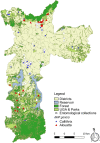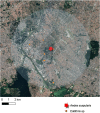Possible non-sylvatic transmission of yellow fever between non-human primates in São Paulo city, Brazil, 2017-2018
- PMID: 32978448
- PMCID: PMC7519641
- DOI: 10.1038/s41598-020-72794-x
Possible non-sylvatic transmission of yellow fever between non-human primates in São Paulo city, Brazil, 2017-2018
Abstract
Yellow Fever (YF) is a severe disease caused by Yellow Fever Virus (YFV), endemic in some parts of Africa and America. In Brazil, YFV is maintained by a sylvatic transmission cycle involving non-human primates (NHP) and forest canopy-dwelling mosquitoes, mainly Haemagogus-spp and Sabethes-spp. Beginning in 2016, Brazil faced one of the largest Yellow Fever (YF) outbreaks in recent decades, mainly in the southeastern region. In São Paulo city, YFV was detected in October 2017 in Aloutta monkeys in an Atlantic Forest area. From 542 NHP, a total of 162 NHP were YFV positive by RT-qPCR and/or immunohistochemistry, being 22 Callithrix-spp. most from urban areas. Entomological collections executed did not detect the presence of strictly sylvatic mosquitoes. Three mosquito pools were positive for YFV, 2 Haemagogus leucocelaenus, and 1 Aedes scapularis. In summary, YFV in the São Paulo urban area was detected mainly in resident marmosets, and synanthropic mosquitoes were likely involved in viral transmission.
Conflict of interest statement
The authors declare no competing interests.
Figures


Similar articles
-
Influence of landscape composition and configuration on the richness and abundance of potential sylvatic yellow fever vectors in a remnant of Atlantic Forest in the city of São Paulo, Brazil.Acta Trop. 2020 Apr;204:105385. doi: 10.1016/j.actatropica.2020.105385. Epub 2020 Feb 3. Acta Trop. 2020. PMID: 32027836
-
Neighbor danger: Yellow fever virus epizootics in urban and urban-rural transition areas of Minas Gerais state, during 2017-2018 yellow fever outbreaks in Brazil.PLoS Negl Trop Dis. 2020 Oct 5;14(10):e0008658. doi: 10.1371/journal.pntd.0008658. eCollection 2020 Oct. PLoS Negl Trop Dis. 2020. PMID: 33017419 Free PMC article.
-
Recent sylvatic yellow fever virus transmission in Brazil: the news from an old disease.Virol J. 2020 Jan 23;17(1):9. doi: 10.1186/s12985-019-1277-7. Virol J. 2020. PMID: 31973727 Free PMC article. Review.
-
Potential risk of re-emergence of urban transmission of Yellow Fever virus in Brazil facilitated by competent Aedes populations.Sci Rep. 2017 Jul 7;7(1):4848. doi: 10.1038/s41598-017-05186-3. Sci Rep. 2017. PMID: 28687779 Free PMC article.
-
Human Urban Arboviruses Can Infect Wild Animals and Jump to Sylvatic Maintenance Cycles in South America.Front Cell Infect Microbiol. 2019 Jul 17;9:259. doi: 10.3389/fcimb.2019.00259. eCollection 2019. Front Cell Infect Microbiol. 2019. PMID: 31380302 Free PMC article. Review.
Cited by
-
Reemergence of yellow fever virus in southeastern Brazil, 2017-2018: What sparked the spread?PLoS Negl Trop Dis. 2022 Feb 7;16(2):e0010133. doi: 10.1371/journal.pntd.0010133. eCollection 2022 Feb. PLoS Negl Trop Dis. 2022. PMID: 35130278 Free PMC article.
-
Microclimate and the vertical stratification of potential bridge vectors of mosquito‑borne viruses captured by nets and ovitraps in a central Amazonian forest bordering Manaus, Brazil.Sci Rep. 2021 Oct 26;11(1):21129. doi: 10.1038/s41598-021-00514-0. Sci Rep. 2021. PMID: 34702887 Free PMC article.
-
Drought dynamics explain once in a century yellow fever virus outbreak in Brazil with implications for climate change.bioRxiv [Preprint]. 2025 Jun 14:2025.02.25.640139. doi: 10.1101/2025.02.25.640139. bioRxiv. 2025. PMID: 40060409 Free PMC article. Preprint.
-
Isolation of a Potently Neutralizing and Protective Human Monoclonal Antibody Targeting Yellow Fever Virus.mBio. 2022 Jun 28;13(3):e0051222. doi: 10.1128/mbio.00512-22. Epub 2022 Apr 14. mBio. 2022. PMID: 35420472 Free PMC article.
-
Parasites and Viruses in Callithrix in Brazil.Acta Parasitol. 2024 Mar;69(1):152-163. doi: 10.1007/s11686-023-00766-y. Epub 2024 Jan 6. Acta Parasitol. 2024. PMID: 38184509 Review.
References
-
- Vasconcelos, P. F. da C. Febre amarela. Revista da Sociedade Brasileira de Medicina Tropical36, 275–293 (2003). - PubMed
MeSH terms
LinkOut - more resources
Full Text Sources
Miscellaneous

